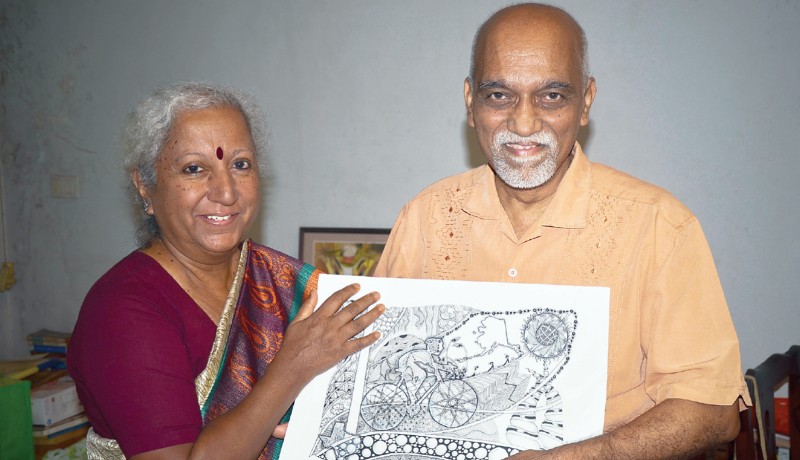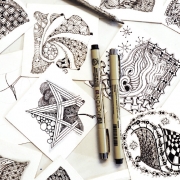
Etcetera

India’s first certified Zentangle teachers Malathi and Dilip Patel are spreading the therapeutic benefits of the art form, reports Chitra Ramaswamy
Meet Malathi and Dilip Patel, India’s first certified Zentangle teachers. Tell them you “can’t draw for nuts” and they will put you at ease. “Anyone can draw a dot, line, loop and curve,” elaborates Malathi. “Combined, these symbols unravel endless patterns, each of which is unique in its abstractness. Once you start drawing, the process will absorb you and you will be amazed at what you are capable of.”
Zentangling is an art form believed to possess the therapeutic effects of meditation. “There is no pre-planning and no post-judgement of a Zentangle creation,” Dilip tells us. “Take your pen for a walk and allow the pattern to reveal itself to you. And while you, artist or no artist, draw consciously, the final outcome is generally an unexpected pattern.”
The word ‘Zentangle’ is derived from the Japanese word ‘zen’ for meditation and English word ‘tangle’. While the process bears resemblance to doodling, to Zentangle is a conscious activity, unlike doodling. A mere 10 minutes spent Zentangling is found to relax the mind, relieve stress, improve focus, increase attention span, improve hand-eye coordination and enable general mindfulness.
Malathi discovered the art quite by accident in 2010. Though she did not know of its therapeutic effects at that time, the spectacular patterns she found online had her fascinated. She had just retired as a helicopter designer for HAL and was all set to play a zestful second innings with a huge to-do list. Unfortunately, her mother fell ill and Malathi was confined to home even as Dilip travelled around the country for his work as a life-skills trainer. “I have always been an active person,” she recalls. “The confinement bogged me down. I became irritable and experienced mood swings.”
She immersed herself in Zentangling. Three weeks later, Dilip noticed how Malathi was slowly returning to her old calm and positive self. “Nothing else around the household had changed, but somehow Malathi had transformed,” he recalls.
Soon the Bengaluru-based couple started practising Zentangling and recording their work on a blog. “The ayah and nurses in the hospital where my mother was admitted were so interested that I started teaching them whatever little I knew,” says Malathi, who never missed an opportunity to advocate the benefits of the artform. Little did she know that this was a sign of things to come.
In January 2012 when Dilip was in Panchgani on work, he participated in a weekly online Zentangle challenge. The challenge was to use the colour purple to create the designs. Away from home and lacking his usual art material, Dilip improvised, creating patterns using twigs, leaves and an assortment of purple flowers. His unique creation attracted a host of visitors to his blog, and was noticed by Rick Roberts and Maria Thomas, the American couple who discovered Zentangling. The Patels were promptly invited to the US to be the couple’s guests and participate in a four-day seminar to become certified Zentangle teachers.
Since then, the Patels have taught over 500 people of all ages in Bengaluru and other cities. The sexagenarian couple experienced firsthand the therapeutic effects of Zentangling on drug and alcohol addicts when they conducted a three-hour session at a rehab facility in the US earlier this year. “That was one of our most satisfying experiences,” says Malathi. “The workshop was conducted for 44 individuals, one of whom wrote in the feedback form: ‘If this method works on us, it will work on anybody. You have tamed the beast in us.’”
The couple witnessed a similar response among 25 women in a government remand home in Bengaluru, for whom they conducted two sessions. “We saw each one of them blossom,” reveals Malathi.
The benefits of the art among silvers, the sick and convalescing have also been remarkable. A 64 year-old woman who was diagnosed with cancer four years ago took to Zentangling and became so addicted that, while she was recovering in hospital after surgery, she Zentangled on tissues! “When I visited her in the hospital, she said it was the only thing that kept her in the present moment, and away from morbid and negative thoughts,” shares Dilip.
The Patels, who conduct regular, onetime, five-hour Zentangle classes, also teach silvers and differently abled individuals free of charge. Slowly but surely, the Patels are spreading the word, one stroke at a time.
THE ART OF ZENTANGLING
Zentangling is easy to learn, relaxing, and a fun way to create beautiful images. It involves drawing repetitive patterns through a series of specified steps. It does not require special abilities to create. In fact, there are no mistakes in Zentangling and, hence, an eraser is never used.
Dots, lines, loops and curves form the four letters of the Zentangle alphabet. It is typically created on 3.5-inch, acid-free, white square papers called ‘tiles’. This space is filled in using a black pen with archival ink for long-lasting effect. The tile is first segmented by a ‘string’ or curved lines that are pulled across in no particular size or shape. These divisions are then filled using combinations of the four letters. It takes about 15-20 minutes to fill out a tile, enough to keep you going for the day.
Essentially, however, Zentangles can be created on any surface—smooth stones, leaves and paper—in any colour and using any medium.
Photos: J Ramaswamy Featured in Harmony — Celebrate Age Magazine December 2017
you may also like to read
-
Cracking the longevity code
Small yet impactful choices can be game-changers, writes Srirekha Pillai At 102, there’s no stopping Chandigarh-based Man Kaur, the world’s….
-
Home, not alone
While a regulatory framework is vital for senior-care facilities, the need of the hour is to develop an ecosystem to….
-
Birthday Girl
Published in a special edition to honour Japanese master storyteller Haruki Murakami’s 70th birthday, Birthday Girl (Penguin; Rs 100; 42….
-
A huge treat for music lovers
Published as the revised and updated second edition, Incomparable Sachin Dev Burman (Blue Pencil; Rs. 599; 470 pages) the authoritative….








